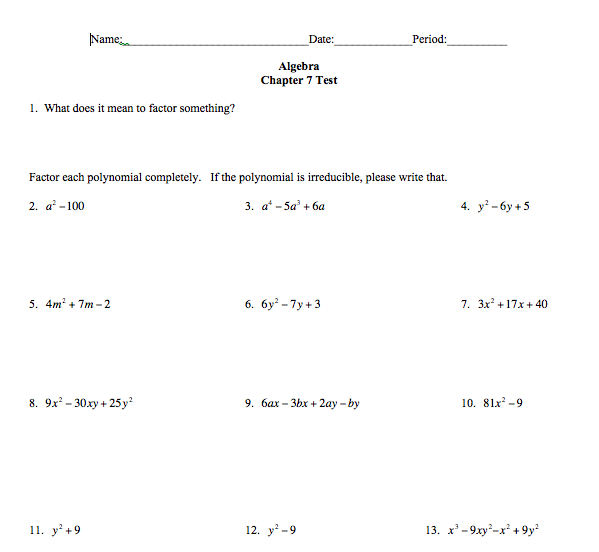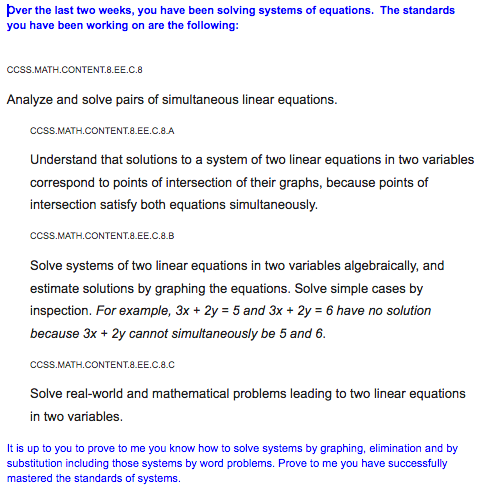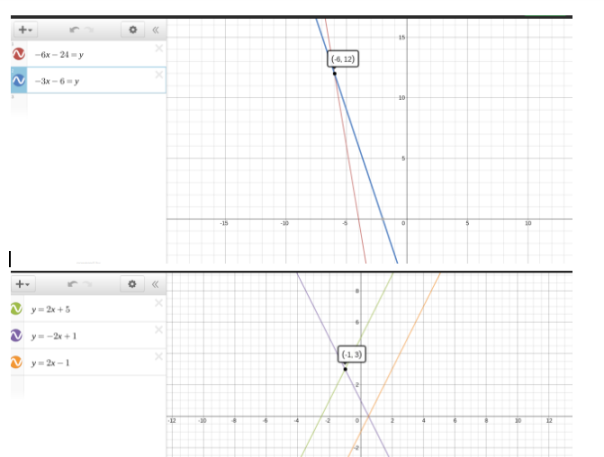Math tests – Why I was failing my students and how I changed.
Why do most math tests look the same?
For 12 years I gave math tests that looked like this:

This test was created and given in 2012 to 8th grade Algebra students. I never intended to make tests that showed nothing more than doing rote memorization of skills. At the time, I honestly thought this was a great test. For 12 years I created tests where a majority of the problems were just like the problems we did in class. I then would put one or two challenging problems and the last question would be a bonus problem. It was the typical way I had always been taught and it was the way all of my tests looked when I was a student. It wasn’t a bad test. It just wasn’t enough.
I never was assessing what the kids were truly learning. Rather, I was assessing whether or not they could mimic the problems in class. Had I given my students a completely different, more challenging problem that required multiple steps and thorough understanding, they would have struggled. The bottom line.. I wasn’t assessing the standard.
In December of 2014 I remember deciding to scrap an assessment for my 7th grade students who were learning how to solve systems of equations. In my mission to give students more choice, I remember throwing out the copies of the paper test and sending them this shared document:

I asked my students to, “prove they have mastered the standard.”
My students opened this document and instantly panic set in. The students started to react:
“What do you want me to do?”
“Tell me exactly what you want”
“How long should the this be?”
“How do I get an A?”
“Where’s the test?”
It became very clear that after all of these years, I had failed my students. They weren’t concerned about the in-depth understanding of the concepts. They wanted to comply. They wanted to play the game of school they were so comfortable with. They wanted to take this test and earn the grade.
I honestly had no clue if this would work. Would my idea crash and burn? Would it take 2 days? 5 days? Did I actually teach them well enough to do what I am now asking from them? To prove understanding.
Students worked for 3 days in class on this. I gave them no direction as to what to actually do. I gave them feedback…quality feedback. One child was working through his presentation to which he said he was finished. The work he had done was superb but I looked over it and noticed he had forgotten an aspect of what it looks like when solving a system would yield an answer other than 1 or 0 solutions. I posed the question to him, “Can you have more than 1 or 0 solutions?” He looked up and said, “Wow, I can’t believe I forgot many solutions.” Back to work he went.
After 3 days, I received presentations, movies, paper tests and a plethora of explanations. It was clear to me. The work I had received was far better than any paper test I could have given. They were proud of what they turned in because it was theirs. They had ownership of the product they produced. I was shocked at the quality of work I saw.
Here are some examples:

In addition to collecting their projects, they would answer the questions I asked verbally. From that point on, I started to ask my students to prove understanding much more.
Let me state that I still believe in paper and pencil tests but the quality of questions I ask has dramatically increased. Questions that ask students to prove to me understanding and allow them choice in how they prove it. That’s the quality I want.
This year when testing students over quadratics, I still gave them a written test in which they had to solve challenging, in-depth problems that asked them to prove understanding. But that wasn’t the end. We went further than a test. I sent them this:

Off to work they went. I gave them no direction into how to determine the “best drinking fountain” except it had to involve quadratics. This is what I saw as I walked around the hallways:
In addition to the paper work and their verbal explanations, this is what my 7th graders turned in:

Then we went further. They built catapults to further than understanding of quadratics:
I now look at assessments differently. They are an opportunity to give students autonomy over how they prove to me understanding. I still give many paper and pencil tests but the questions asked always ask for them to prove or explain. I believe that if students truly understand the material, then they are able to explain the concept to someone else.
My challenge to you is to do something different. Step outside your comfort zone even if on the inside you are saying, “my kids could never do this.” On your next assessment simply write on the board, “Prove to me mastery over…” and see what happens. You might, too, be incredibly surprised.
Posted on August 24, 2016, in Uncategorized. Bookmark the permalink. 2 Comments.








Thank you for sharing and thank you for continuing to question your own practices in order to evolve as an educator! Great stuff!
LikeLiked by 1 person
Pingback: Loving Local – Shoutout to Illinois Bloggers – Functions Are Fun